Network Elements and Solution Methods: Set 1
[1992: 1 M] All resistances in figure are 1 \Omega each. The value of current ”I ” is
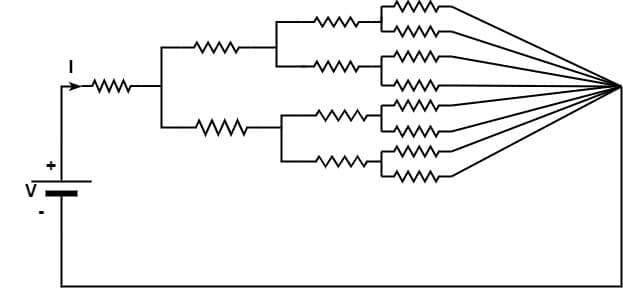
a)\frac1{15}A
b)\frac2{15}A
c)\frac4{15}A
d)\frac8{15}A
Ans. (d)
Explanation:
R\;=\;1+\;\lbrack1\;\parallel1+1)\parallel\;(1\parallel1+1)+1\;\rbrack\;\parallel(1\parallel1+1)\parallel(1\parallel1+1)+1\rbrack R=\frac{15}8\Omega \therefore I\;=\frac VR\;=\frac1{\displaystyle\frac{15}8}=\frac8{15}A[1992: 1 M] All resistances in the circuit in figure are of R Ohms each. The switch is initially open. What happens to the lamp’s intensity when the switch is closed?
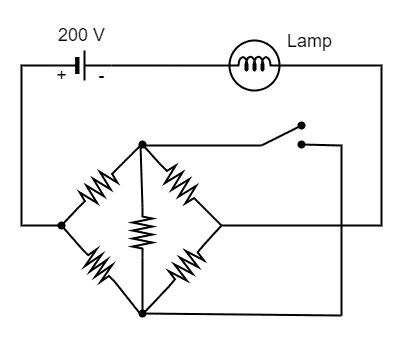
a) Increases
b) Decreases
c) Remains same
d) Answer depends on the value of R
Ans. (c)
Explanation:
It is given that, the wheatstone bridge is balanced, so the current flowing through the lamp will remain same irrespective of the state of switch. Therefore, the intensity of lamp will remain same.
[1992: 2 M] The equivalent inductance seen at terminals A-B in figure is …………….. H.
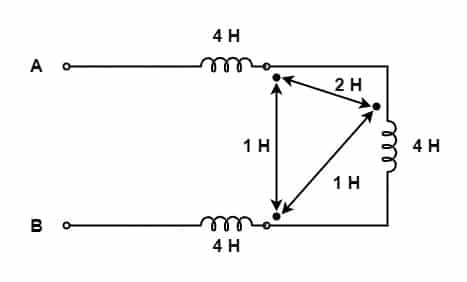
Ans. L=8 H
Explanation:
L1 = 4H; L2 = 4H; L3 = 4H; M12 = 2H; M23 = 1H; M13 = 1H
L=L_1+L_2+L_3-2M_{12}+2M_{23}-2M_{13} =4+4+4-(2\times2)+(2\times1)-(2\times1)=8Hence, L = 8 H
[1992: 2 M] Using Thevenin equivalent circuit, determine the rms value of the voltage across the 100 ohm resistor after the switch is closed in the 3 phase circuit shown in figure.
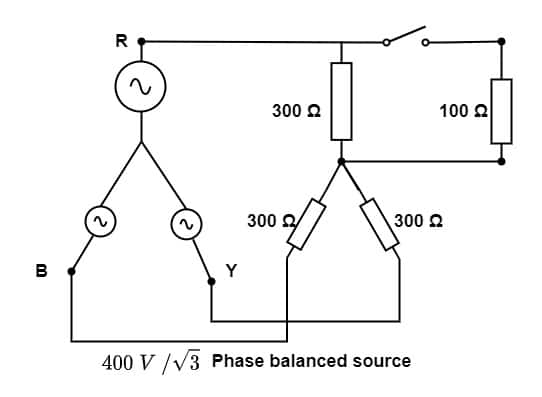
Ans. 115.5 V.
Explanation:
V_{Th}\;=V_{ph}\;=\frac{400}{\sqrt3}\simeq231V
For Thevenin’s equivalent, we will replace all the independent voltage sources by short circuit, open the load and we’ll find the equivalent ZTh across the points across the load terminals i.e. P and Q
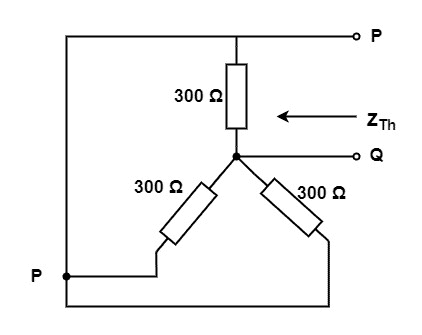
Hence, Thevenin’s equivalent is given as
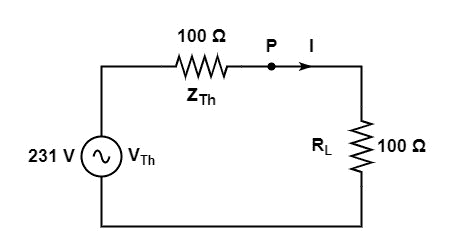
Hence, voltage across 100Ω resistor, using voltage division,
=231\times\frac{100}{100+100} =\frac{231}2=115.5V[1994: 2 M] In the given circuit, the voltage VL has phase angle of _____with respect to Vs .
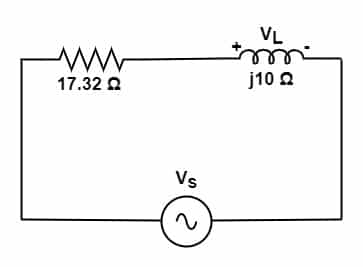
Ans. 60o
Explanation:
Using voltage division rule, we have,
V_L\;=V_s\;\times\frac{j10}{17.32+j10} =V_s\;\times0.5\angle60^\circ\;voltsHence, VL has a phase angle of 600 with respect to Vs.
[1994: 2 M] A set of 3 equal resistors, each of value Rx , connected in star across RYB of given figure consumes the same power as the unbalanced delta connected load shown. The value of Rx is ____Ω.
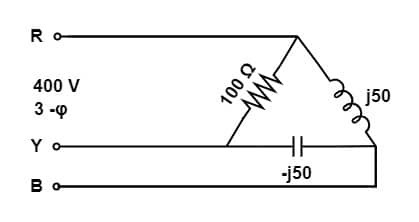
Ans. 100 Ω
Explanation:
We know that, only resistor consume power, neither inductor nor capacitor.
Hence, power consumed in unbalanced delta is given as,
\frac{{V^2}_{ph}}R=\frac{{V^2}_L}R=\frac{\left(400\right)^2}{100}=1600WGiven that, power consumed in a balanced star with equal resistance of Rx is same as the above.
So, power consumed in a balanced star with equal resistance of Rx is given as,
3\left[\frac{{V^2}_{Ph}}{R_x}\right]=\frac{{V^2}_L}{R_x}=\frac{\left(400\right)^2}R 1600=\;\frac{\left(400\right)^2}R R=\;100\Omega[1995: 1 M] In the circuit shown in figure, ammeter A2 reads 12A and A3 reads 9A. A1 will read ____A.
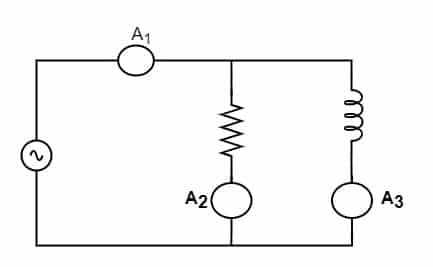
Ans. 15 A
Explanation:
Currents in resistor and inductor will have 900 phase difference. Hence,
I_{A1}=\sqrt{I_{A2}^2+I_{A3}^2}=\sqrt{12^2+9^2}=15A[1996: 1 M] In the circuit shown in figure, X is an element which always absorb power. During a particular operation, It sets up a current of 1 amp in the direction shown and absorbs a power Px. It is possible that X can absorb the same power Px for anther current i. Then the value of this current is
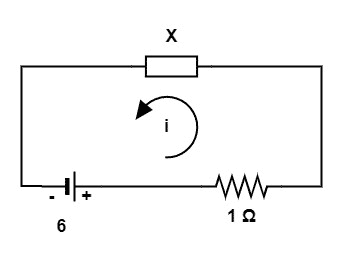
a) \left(3\;-\;\sqrt{14}\right)amps
b) \left(3\;+\;\sqrt{14}\right)amps
c) 5 amps
d) None of these
Ans. (c)
Explanation:
Let us consider the PX as the power absorbed
I can be calculated as,
P_x\;=P_6v\;-\;P_{1\Omega}\; =\;6\;\times1\;-\;1^2\;\times1Px= 5 W
By Analyzing the given option and checking one by one the value of current obtained is i=5 A.
P_x\;=(6\times5)\;-\left(5^2\;\times1\right)Option (C) is correct.
[1997: 1 M] A practical current source is usually represented by
a) a resistance in series with an ideal current source.
b) a resistance in parallel with an ideal current source.
c) a resistance in parallel with an ideal voltage source.
d) none of these.
Ans. (b)
Explanation: We know that a practical current source is represented by a resistance in parallel with an ideal current source and a practical voltage source is usually represented by resistance in series with an ideal voltage source.
[1997: 1 M] Energy stored in capacitor over a cycle, when excited by an a. c. source is
a) the same as that due to a d. c. source of equivalent magnitude.
b) half of that due to a d .c. source of equivalent magnitude.
c) Zero.
d) none of the above.
Ans. (c)
Explanation:
Capacitor stores the energy in one half cycle and delivers it in next half cycle. Hence total energy stored in a capacitor over a complete cycle when excited by an ac source is zero.
[1997: 2 M] Two identical coils of negligible resistance when connected in series across a 200 V, 50 Hz source draws a current of 10A. When the terminals of one of the coils are reversed, then current drawn is 8 A. The coefficient of coupling between the two coils is ____.
Ans. 1/9
Explanation:
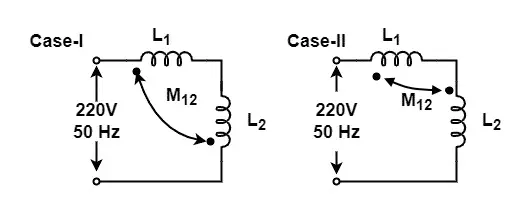
Case 1 must be for 10 A current and case 2 for 8A, as in case 1 effective inducance would be less hence more current and vice-versa in case 2.
\left|I_1\;\right|\;=\;\frac V{\omega(L_1\;+L_{2\;}-2M_{12})} \left|I_2\;\right|\;=\;\frac V{\omega(L_1\;+L_{2\;}+2M_{12})}\therefore\;Taking\;\left|I_1\right|\;=10\;A\;and\;\left|I_2\right|\;=8A and putting, V=220V and L1 = L2 = L
we have ,
10\;\;=\frac{200}{\omega(2L-2M_{12})}\;\;\;\cdots\cdots\cdots\cdots(i) 8\;\;=\frac{200}{\omega(2L-2M_{12})}\;\;\;\cdots\cdots\cdots\cdots(ii)On solving equation (i) and equation (ii)
M_{12}\;=\frac19\;L M_{12}\;=\frac19\sqrt{L.L}\;=\frac19\sqrt{L_1\;.L_2}Hence, coefficient of coupling = \frac19
[1997: 2 M] A 10 V battery with an internal resistance of 1 Ω is connected across a non-linear load whose V-I characteristic is given by 7 I =V2 +2 V. The current delivered by the battery is ____A.
Ans. 5 A
Explanation:

using KVL.
V+ I = 10
Given, 7I = V2 +2V
On solving equation (i) and equation (ii)
we get, V = 5 V
I =5 A
